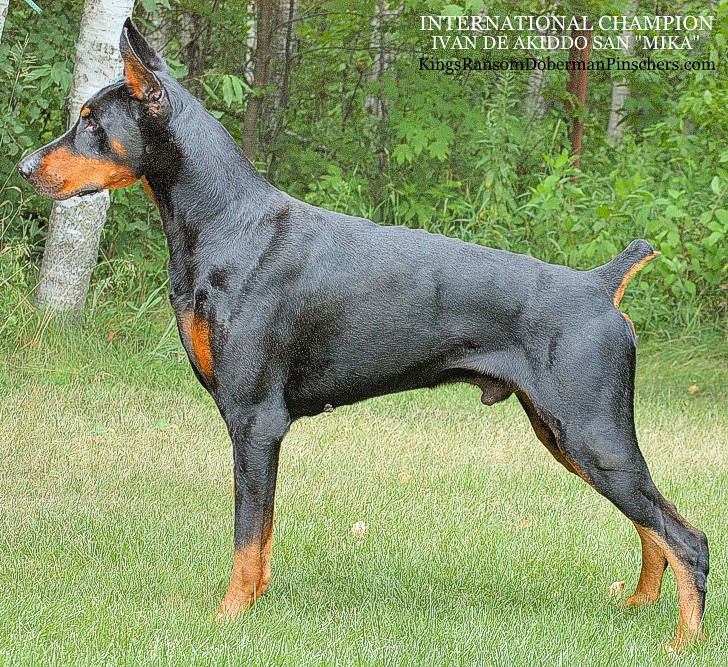
Doberman Pinscher

Navigate through the tabs
Navigate through the tabs below to view the breed's info of your interest.
The breed's info is divided in four sections; namely:
the breed's history ,
the breed's main stats ,
the dog's potential health issues
and finally, how the breed scored in 26 different categories.
All the above information should give you a respectively good overview for the dog of your interest.
Dog Breed's Main Info
The Breed's History:
Doberman Pinschers were first bred in the town of Apolda, in the German state of Thuringia around 1890, following the Franco-Prussian War by Karl Friedrich Louis Dobermann. Dobermann served in the dangerous role of local tax collector, and ran the Apolda dog pound.
With access to dogs of many breeds, he aimed to create a breed that would be ideal for protecting him during his collections, which took him through many bandit-infested areas.
He set out to breed a new type of dog that, in his opinion, would be the perfect combination of strength, speed, endurance, loyalty, intelligence, and ferocity. Later, Otto Goeller and Philip Greunig continued to develop the breed to become the dog that is seen today.
The breed is believed to have been created from several different breeds of dogs that had the characteristics that Dobermann was looking for, including the German Pinscher, the Beauceron, the Rottweiler, the Thuringian Sylvan Dog, the Greyhound, the Great Dane, the Weimaraner, the German Shorthaired Pointer, the Manchester Terrier, the Old German Shepherd Dog, the Thuringian Shepherd Dog.
The exact ratios of mixing, and even the exact breeds that were used, remain uncertain to this day, although many experts believe that the Doberman Pinscher is a combination of at least four of these breeds. The single exception is the documented crossing with the Greyhound and Manchester Terrier.
It is also widely believed that the old German Shepherd gene pool was the single largest contributor to the Doberman breed. Philip Greunig's The Dobermann Pinscher (1939), is considered the foremost study of the development of the breed by one of its most ardent students.
Greunig's study describes the breed's early development by Otto Goeller, whose hand allowed the Doberman to become the dog we recognize today. The American Kennel Club believes the breeds utilized to develop the Doberman Pinscher may have included the old shorthaired shepherd, Rottweiler, Black and Tan Terrier and the German Pinscher.
After Dobermann's death in 1894, the Germans named the breed Dobermann-pinscher in his honor, but a half century later dropped the "pinscher" on the grounds that this German word for terrier was no longer appropriate. The British did the same a few years later. Its official name, however, is still "Doberman Pinscher" (although the person's name is spelled with 2 "n"s).
During World War II, the United States Marine Corps adopted the Doberman Pinscher as its official War Dog, although the Corps did not exclusively use this breed in the role.
In the post war era the breed was nearly lost. There were no new litters registered in West Germany from 1949 to 1958.
Werner Jung is credited with single-handedly saving the breed. He searched the farms in Germany for typical Pinschers and used these along with 4 oversized Miniature Pinschers and a black and red bitch from East Germany.
Jung risked his life to smuggle her into West Germany. Most German Pinschers today are descendants of these dogs. Some pedigrees in the 1959 PSK Standardbuch show a number of dogs with unknown parentage.
In the United States, the American Kennel Club ranked the Doberman Pinscher as the 12th most popular dog breed in 2012 and 2013.
Country of Origin:
Germany
Breed Group:
Working
Height:
2 feet to 2 feet, 4 inch. (60,96 to 71,12 cm)
Weight:
60 to 80 pounds (27,21 to 36,29 Kg)
Life Span:
10 to 13 years
Potential Health Issues:
Von Willebrand's Disease,
Hip Dysplasia,
Progressive Retinal Atrophy (PRA),
Hypothyroidism,
Wobbler's Syndrome,
Cardiomyopathy,
Albinoism,
Color Mutant Alopecia,
Narcolepsy,
Gastric Dilatation-Volvulus
Adaptability
Apartment Living:
First Time Owners:
Sensitivity:
Being Alone:
Cold Weather:
Hot Weather:
Friendliness
Affection With Family:
With Kids:
With Dogs:
With Strangers:
Health and Grooming
Shedding:
Drooling:
Easy To Groom:
Overall Health:
Weight Gain Potential:
Size:
Training
Easiness:
Intelligence:
Mouthiness:
Prey Drive:
Barking or Howling:
Wanderlust:
Need For Exercise
Energy Level:
Intensity:
Exercise Needs:
Playfulness:
Our Mobile Application
Check out Our Mobile Application "Dog Breeds Central"
